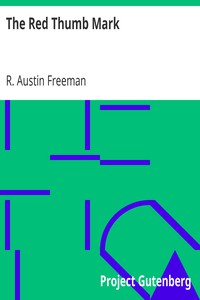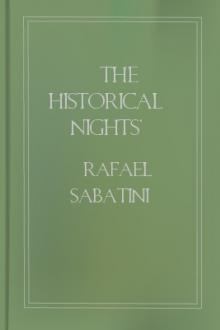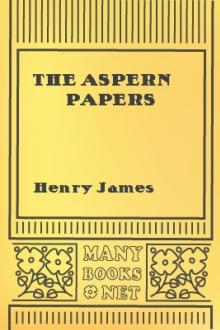The Red Thumb Mark by R. Austin Freeman (best books to read in life .TXT) 📖

- Author: R. Austin Freeman
Book online «The Red Thumb Mark by R. Austin Freeman (best books to read in life .TXT) 📖». Author R. Austin Freeman
"Do you say that—having regard to the facts which you have stated—it is certain that the red thumb-mark is a forgery?"
"I do; and I also say that it is certain that the forgery was executed by means of the 'Thumbograph.'"
"Might not the resemblances be merely a coincidence?"
"No. By the law of probabilities which Mr. Singleton explained so clearly in his evidence, the adverse chances would run into untold millions. Here are two thumb-prints made in different places and at different times—an interval of many weeks intervening. Each of them bears an accidental mark which is due not to any peculiarity of the thumb, but to a peculiarity of the paper. On the theory of coincidences it is necessary to suppose that each piece of paper had a loose fibre of exactly identical shape and size and that this fibre came, by accident, in contact with the thumb at exactly the same spot. But such a supposition would be more opposed to probabilities even than the supposition that two exactly similar thumb-prints should have been made by different persons. And then there is the further fact that the paper found in the safe had no loose fibre to account for the mark."
"What is your explanation of the presence of defibrinated blood in the safe?"
"It was probably used by the forger in making the thumb-print, for which purpose fresh blood would be less suitable by reason of its clotting. He would probably have carried a small quantity in a bottle, together with the pocket slab and roller invented by Mr. Galton. It would thus be possible for him to put a drop on the slab, roll it out into a thin film and take a clean impression with his stamp. It must be remembered that these precautions were quite necessary, since he had to make a recognisable print at the first attempt. A failure and a second trial would have destroyed the accidental appearance, and might have aroused suspicion."
"You have made some enlarged photographs of the thumb-prints, have you not?"
"Yes. I have here two enlarged photographs, one of the 'Thumbograph' print and one of the red thumb-print. They both show the white mark very clearly and will assist comparison of the originals, in which the mark is plainly visible through a lens."
He handed the two photographs up to the judge, together with the 'Thumbograph,' the memorandum slip, and a powerful doublet lens with which to examine them.
The judge inspected the two original documents with the aid of the lens and compared them with the photographs, nodding approvingly as he made out the points of agreement. Then he passed them on to the jury and made an entry in his notes.
While this was going on my attention was attracted by Walter Hornby. An expression of terror and wild despair had settled on his face, which was ghastly in its pallor and bedewed with sweat. He looked furtively at Thorndyke and, as I noted the murderous hate in his eyes, I recalled our midnight adventure in John Street and the mysterious cigar.
Suddenly he rose to his feet, wiping his brow and steadying himself against the bench with a shaking hand; then he walked quietly to the door and went out. Apparently, I was not the only onlooker who had been interested in his doings, for, as the door swung to after him, Superintendent Miller rose from his seat and went out by the other door.
"Are you cross-examining this witness?" the judge inquired, glancing at Sir Hector Trumpler.
"No, my lord," was the reply.
"Are you calling any more witnesses, Mr. Anstey?"
"Only one, my lord," replied Anstey—"the prisoner, whom I shall put in the witness-box, as a matter of form, in order that he may make a statement on oath."
Reuben was accordingly conducted from the dock to the witness-box, and, having been sworn, made a solemn declaration of his innocence. A brief cross-examination followed, in which nothing was elicited, but that Reuben had spent the evening at his club and gone home to his rooms about half-past eleven and had let himself in with his latchkey. Sir Hector at length sat down; the prisoner was led back to the dock, and the Court settled itself to listen to the speeches of the counsel.
"My lord and gentlemen of the jury," Anstey commenced in his clear, mellow tones, "I do not propose to occupy your time with a long speech. The evidence that has been laid before you is at once so intelligible, so lucid, and so conclusive, that you will, no doubt, arrive at your verdict uninfluenced by any display of rhetoric either on my part or on the part of the learned counsel for the prosecution.
"Nevertheless, it is desirable to disentangle from the mass of evidence those facts which are really vital and crucial.
"Now the one fact which stands out and dominates the whole case is this: The prisoner's connection with this case rests solely upon the police theory of the infallibility of finger-prints. Apart from the evidence of the thumb-print there is not, and there never was, the faintest breath of suspicion against him. You have heard him described as a man of unsullied honour, as a man whose character is above reproach; a man who is trusted implicitly by those who have had dealings with him. And this character was not given by a casual stranger, but by one who has known him from childhood. His record is an unbroken record of honourable conduct; his life has been that of a clean-living, straightforward gentleman. And now he stands before you charged with a miserable, paltry theft; charged with having robbed that generous friend, the brother of his own father, the guardian of his childhood and the benefactor who has planned and striven for his well-being; charged, in short, gentlemen, with a crime which every circumstance connected with him and every trait of his known character renders utterly inconceivable. Now upon what grounds has this gentleman of irreproachable character been charged with this mean and sordid crime? Baldly stated, the grounds of the accusation are these: A certain learned and eminent man of science has made a statement, which the police have not merely accepted but have, in practice, extended beyond its original meaning. That statement is as follows: 'A complete, or nearly complete, accordance between two prints of a single finger ... affords evidence requiring no corroboration, that the persons from whom they were made are the same.'
"That statement, gentlemen, is in the highest degree misleading, and ought not to have been made without due warning and qualification. So far is it from being true, in practice, that its exact contrary is the fact; the evidence of a finger-print, in the absence of corroboration, is absolutely worthless. Of all forms of forgery, the forgery of a finger-print is the easiest and most secure, as you have seen in this court to-day. Consider the character of the high-class forger—his skill, his ingenuity, his resource. Think of the forged banknotes, of which not only the engraving, the design and the signature, but even the very paper with its private watermarks, is imitated with a perfection that is at once the admiration and the despair of those who have to distinguish the true from the false; think of the forged cheque, in which actual perforations are filled up, of which portions are cut out bodily and replaced by indistinguishable patches; think of these, and then of a finger-print, of which any photo-engraver's apprentice can make you a forgery that the greatest experts cannot distinguish from the original, which any capable amateur can imitate beyond detection after a month's practice; and then ask yourselves if this is the kind of evidence on which, without any support or corroboration, a gentleman of honour and position should be dragged before a criminal court and charged with having committed a crime of the basest and most sordid type.
"But I must not detain you with unnecessary appeals. I will remind you briefly of the salient facts. The case for the prosecution rests upon the assertion that the thumb-print found in the safe was made by the thumb of the prisoner. If that thumb-print was not made by the prisoner, there is not only no case against him but no suspicion of any kind.
"Now, was that thumb-print made by the prisoner's thumb? You have had conclusive evidence that it was not. That thumb-print differed in the size, or scale, of the pattern from a genuine thumb-print of the prisoner's. The difference was small, but it was fatal to the police theory; the two prints were not identical.
"But, if not the prisoner's thumb-print, what was it? The resemblance of the pattern was too exact for it to be the thumb-print of another person, for it reproduced not only the pattern of the ridges on the prisoner's thumb, but also the scar of an old wound. The answer that I propose to this question is, that it was an intentional imitation of the prisoner's thumb-print, made with the purpose of fixing suspicion on the prisoner, and so ensuring the safety of the actual criminal. Are there any facts which support this theory? Yes, there are several facts which support it very strongly.
"First, there are the facts that I have just mentioned. The red thumb-print disagreed with the genuine print in its scale or dimensions. It was not the prisoner's thumb-print; but neither was it that of any other person. The only alternative is that it was a forgery.
"In the second place, that print was evidently made with the aid of certain appliances and materials, and one of those materials, namely defibrinated blood, was found in the safe.
"In the third place, there is the coincidence that the print was one which it was possible to forge. The prisoner has ten digits—eight fingers and two thumbs. But there were in existence actual prints of the two thumbs, whereas no prints of the fingers were in existence; hence it would have been impossible to forge a print of any of the fingers. So it happens that the red thumb-print resembled one of the two prints of which forgery was possible.
"In the fourth place, the red thumb-print reproduces an accidental peculiarity of the 'Thumbograph' print. Now, if the red thumb-print is a forgery, it must have been made from the 'Thumbograph' print, since there exists no other print from which it could have been made. Hence we have the striking fact that the red thumb-print is an exact replica—including accidental peculiarities—of the only print from which a forgery could have been made. The accidental S-shaped mark in the 'Thumbograph'
 Have you ever thought about what fiction is? Probably, such a question may seem surprising: and so everything is clear. Every person throughout his life has to repeatedly create the works he needs for specific purposes - statements, autobiographies, dictations - using not gypsum or clay, not musical notes, not paints, but just a word. At the same time, almost every person will be very surprised if he is told that he thereby created a work of fiction, which is very different from visual art, music and sculpture making. However, everyone understands that a student's essay or dictation is fundamentally different from novels, short stories, news that are created by professional writers. In the works of professionals there is the most important difference - excogitation. But, oddly enough, in a school literature course, you don’t realize the full power of fiction. So using our website in your free time discover fiction for yourself.
Have you ever thought about what fiction is? Probably, such a question may seem surprising: and so everything is clear. Every person throughout his life has to repeatedly create the works he needs for specific purposes - statements, autobiographies, dictations - using not gypsum or clay, not musical notes, not paints, but just a word. At the same time, almost every person will be very surprised if he is told that he thereby created a work of fiction, which is very different from visual art, music and sculpture making. However, everyone understands that a student's essay or dictation is fundamentally different from novels, short stories, news that are created by professional writers. In the works of professionals there is the most important difference - excogitation. But, oddly enough, in a school literature course, you don’t realize the full power of fiction. So using our website in your free time discover fiction for yourself. 




Comments (0)